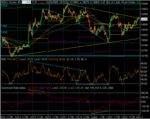Could this be the thin edge of the wedge :!:
Dec. 23 (Bloomberg) -- U.S. new home sales fell more than expected in November as rising mortgage rates and elevated prices discouraged some buyers, leaving a record number of homes on the market. Purchases fell 11.3 percent to a 1.245 million annual rate from October's revised 1.404 million pace, which was a record, the Commerce Department said today in Washington. The median price of a new home rose last month to $225,200 from $224,500 a year earlier. New home sales in the first 11 months almost set a fifth straight annual record, an achievement that won't be repeated in 2006 as rising borrowing costs make houses less affordable, economists said. The fall-off will slow the economy and make business more difficult for homebuilders such as Toll Brothers Inc., whose stock price fell 29 percent in the last six months.
``This suggests a correction from the unexpected record surge we saw in October,'' Ellen Beeson Zentner, an economist at Bank of Tokyo-Mitsubishi Ltd. in New York, said before the report. ``A huge amount of this decline is due to rising mortgage rates, which are the largest factor in home sales and are expected to continue to increase as the Fed raises interest rates.''
The number of homes for sale at the end of the month increased to a record 503,000 in November from 487,000 a month earlier. The supply of new homes at the current sales pace rose to 4.9 months, the most since December 1996, from October's 4.2 months.
Sales fell in three of four regions. They decreased 22.1 percent in the West, the biggest fall in more than 10 years, to 342,000; 18.3 percent in the Midwest to 156,000; and 5.5 percent in the South to 654,000. They rose 13.4 percent in the Northeast to 93,000.
Americans actually bought 85,000 new homes in November, about 1,000 sales short of a new annual record. That brings the total for the year to 1.202 million. The record is 1.203 million, set in 2004. The average rate on a 30-year fixed mortgage rose to 6.33 percent last month from 6.06 percent in October. That compares with 5.85 percent for the year and 9.5 percent since Jan. 1, 1980, according to Freddie Mac, the No. 2 U.S. mortgage buyer. This month, the 30-year rate averaged 6.29 percent. At October's average, the monthly payment on a $100,000 loan would be $620.93. When mortgage rates were at a 40-year low of 5.21 percent in June 2003, the cost was $549.73 a month.
The Federal Reserve on Dec. 13 raised its benchmark lending rate for a 13th consecutive time, to 4.25 percent, to slow inflation and remove what outgoing Fed Chairman Alan Greenspan has called ``froth'' in the housing market. Mortgage rates, which mostly fell for the first year after the Fed began increasing interest rates in June 2004, are now climbing. Economists surveyed by Bloomberg predict the Fed will raise rates by a quarter percentage point in the first quarter and again in the second quarter. Bruce Karatz, chief executive officer of KB Home, said speculators began leaving the housing market six months ago. The Los Angeles-based company is the fifth-largest U.S. homebuilder by stock market value. KB Home's $7 billion backlog is 40 percent higher than it was a year ago, Karatz said in an interview last week. He expects the largest home building companies to gain market share in a more competitive environment and attributes this month's decline in homebuilder confidence -- a 32-month-low -- to worried smaller companies.
New home sales make up about 15 percent of total sales and existing home sales account for the rest. The National Association of Realtors probably will report on Dec. 29 that existing home sales fell to a 7 million annual rate in November from 7.09 million the prior month, economists surveyed by Bloomberg News said. The existing sales index tracks contract closings, which typically lag signings by a month or two. ``The market isn't as vibrant as it was six months ago,'' Joel Rassman, chief financial officer of Toll Brothers, said in a Dec. 20 interview. Horsham, Pennsylvania-based Toll Brothers, the largest U.S. builder of luxury homes, reduced its 2006 sales forecast Nov. 6, saying the housing market is weakening.
The National Association of Home Builders is forecasting a 6.5 percent drop in new home sales next year. The Mortgage Bankers Association is predicting a 3.3 percent drop and the National Association of Realtors expects a 4.8 percent decrease The sales decline may accelerate this quarter as consumers try to lock-in borrowing costs before they rise further. A slower housing sector may mean fewer jobs in mortgage lending, real estate and construction. Since 2001, the housing market accounted for 50 percent of U.S. economic growth and more than half of private payroll jobs creation, according to a report in August by Merrill Lynch & Co., the world's largest securities firm. U.S. mortgage lenders will trim 10 percent to 15 percent of their record 535,000 employees next year, said Orawin Velz, director of forecasting at the Mortgage Bankers Association.
``We're expecting a decline in employment because we expect the volume of originations to decline pretty significantly next year -- 20 percent,'' Velz said.
The number of mortgage applications fell to the second-lowest level this year in the week ended Dec. 16, according to the mortgage bankers' group. The decline in home sales and price appreciation next year may slow consumer spending and economic growth. The U.S. economy grew at a 4.1 percent annual rate in the third quarter, and may average 3.4 percent next year, according to a Bloomberg News survey of 72 economists published Dec. 9. Consumer spending will average 2.8 percent next year, the survey showed, after rising 4.1 percent in the third quarter.
``The housing market is definitely cooling,''' said Richard Yamarone, chief economist at Argus Research Corp. in New York. This suggests that the October record was the result of last minute purchasers in a rising mortgage rate environment.''


